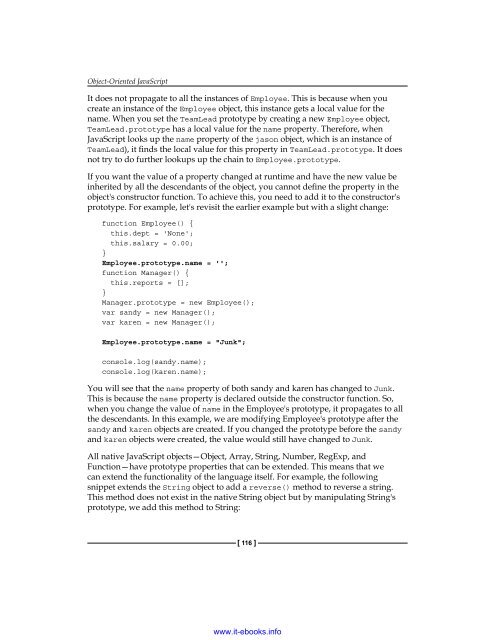Create successful ePaper yourself
Turn your PDF publications into a flip-book with our unique Google optimized e-Paper software.
Object-Oriented <strong>JavaScript</strong><br />
It does not propagate to all the instances of Employee. This is because when you<br />
create an instance of the Employee object, this instance gets a local value for the<br />
name. When you set the TeamLead prototype by creating a new Employee object,<br />
TeamLead.prototype has a local value for the name property. Therefore, when<br />
<strong>JavaScript</strong> looks up the name property of the jason object, which is an instance of<br />
TeamLead), it finds the local value for this property in TeamLead.prototype. It does<br />
not try to do further lookups up the chain to Employee.prototype.<br />
If you want the value of a property changed at runtime and have the new value be<br />
inherited by all the descendants of the object, you cannot define the property in the<br />
object's constructor function. To achieve this, you need to add it to the constructor's<br />
prototype. For example, let's revisit the earlier example but with a slight change:<br />
function Employee() {<br />
this.dept = 'None';<br />
this.salary = 0.00;<br />
}<br />
Employee.prototype.name = '';<br />
function Manager() {<br />
this.reports = [];<br />
}<br />
Manager.prototype = new Employee();<br />
var sandy = new Manager();<br />
var karen = new Manager();<br />
Employee.prototype.name = "Junk";<br />
console.log(sandy.name);<br />
console.log(karen.name);<br />
You will see that the name property of both sandy and karen has changed to Junk.<br />
This is because the name property is declared outside the constructor function. So,<br />
when you change the value of name in the Employee's prototype, it propagates to all<br />
the descendants. In this example, we are modifying Employee's prototype after the<br />
sandy and karen objects are created. If you changed the prototype before the sandy<br />
and karen objects were created, the value would still have changed to Junk.<br />
All native <strong>JavaScript</strong> objects—Object, Array, String, Number, RegExp, and<br />
Function—have prototype properties that can be extended. This means that we<br />
can extend the functionality of the language itself. For example, the following<br />
snippet extends the String object to add a reverse() method to reverse a string.<br />
This method does not exist in the native String object but by manipulating String's<br />
prototype, we add this method to String:<br />
[ 116 ]<br />
www.it-ebooks.info


